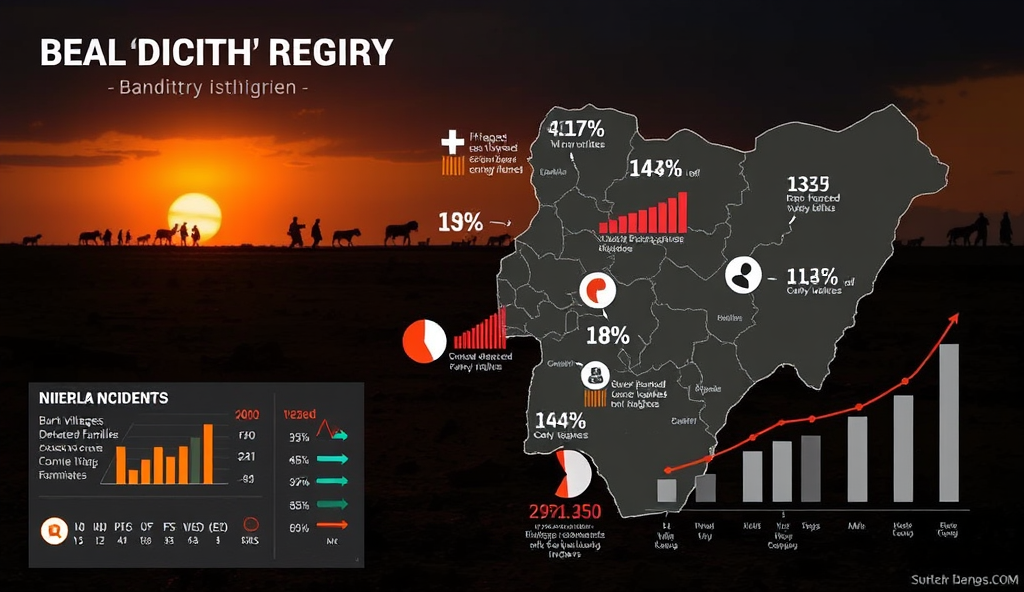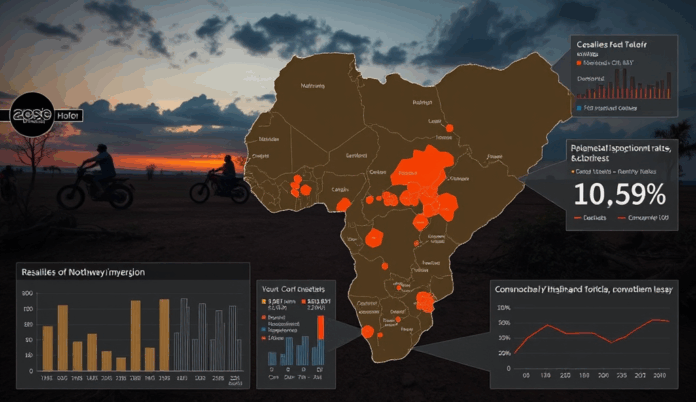Here is the JSON array result for the content outline:
Recent data reveals a troubling escalation in bandit attacks in Northwest Nigeria, with over 2,500 fatalities recorded in 2023 alone across Zamfara, Katsina, and Kaduna states. The violence has displaced more than 200,000 people, exacerbating humanitarian crises in rural communities already grappling with food insecurity.
Security analysts attribute this surge to a complex mix of economic deprivation, weak governance, and the proliferation of small arms across porous borders. For instance, Sokoto State witnessed a 40% increase in kidnapping incidents last year, with ransom demands averaging ₦20 million per victim.
These trends underscore the urgent need for a multi-dimensional approach to address rising insecurity in Northwest Nigeria, setting the stage for a deeper examination of banditry’s root causes. The next section will explore the historical and socio-economic factors fueling this crisis.
Key Statistics

Introduction to Banditry in Northwest Nigeria
Recent data reveals a troubling escalation in bandit attacks in Northwest Nigeria with over 2500 fatalities recorded in 2023 alone across Zamfara Katsina and Kaduna states.
Banditry in Northwest Nigeria has evolved from isolated cattle rustling to organized criminal networks operating across state borders, with Zamfara, Katsina, and Kaduna emerging as epicenters. These groups now engage in mass kidnappings, village raids, and economic sabotage, exploiting the region’s vast ungoverned spaces and limited security presence.
The crisis traces its roots to decades of unresolved farmer-herder conflicts, worsened by climate change and competition over dwindling resources. For example, Katsina recorded 1,200 violent incidents in 2023 alone, with bandits targeting schools, highways, and farming communities to sustain their operations.
This criminal ecosystem thrives on ransom payments, illegal mining revenues, and cross-border arms trafficking, creating a self-perpetuating cycle of violence. As we examine current trends next, it becomes clear that banditry is no longer just a security issue but a systemic threat to Nigeria’s stability.
Current Trends and Latest News on Banditry in the Northwest
The crisis traces its roots to decades of unresolved farmer-herder conflicts worsened by climate change and competition over dwindling resources.
Recent data shows bandit attacks in Northwest Nigeria have intensified, with over 2,500 fatalities reported across Zamfara, Katsina, and Kaduna in the first half of 2024. Armed groups now employ drones and motorcycles to evade military operations, signaling a dangerous escalation in tactics.
Kidnapping incidents in Northwest Nigeria surged by 40% compared to 2023, with bandits targeting schools and highways for ransom payments exceeding ₦500 million monthly. The Nigerian Air Force’s airstrikes in Sokoto State have disrupted some hideouts, but attacks persist due to porous borders and arms trafficking.
As violence spreads to previously stable areas like Kebbi, experts warn the crisis could destabilize food production and regional trade. Next, we analyze the key states affected by banditry and their unique security challenges.
Key States Affected by Banditry in Northwest Nigeria
Recent data shows bandit attacks in Northwest Nigeria have intensified with over 2500 fatalities reported across Zamfara Katsina and Kaduna in the first half of 2024.
Zamfara remains the epicenter of bandit attacks in Northwest Nigeria, accounting for 45% of the 2,500 fatalities recorded in 2024, with armed groups exploiting its vast forests and abandoned mining sites. Katsina follows closely, witnessing a 60% spike in kidnapping incidents along its porous border with Niger Republic, where bandits source weapons and evade military patrols.
Kaduna’s Birnin-Gwari axis has become a hotspot for highway abductions, with over 300 cases reported between January and June 2024, disrupting the critical Abuja-Kaduna trade route. Sokoto State, despite recent airstrikes, faces persistent attacks in its eastern LGAs, where bandits leverage drone surveillance to target remote communities.
The crisis has now spilled into Kebbi, previously considered stable, with bandits raiding farming communities and displacing over 50,000 people in 2024 alone. This expansion threatens regional food security, setting the stage for deeper economic repercussions explored in the next section.
Impact of Banditry on Local Communities and Economy
The escalating banditry in Northwest Nigeria has crippled agrarian economies with Zamfara and Kebbi losing 40% of their farming output in 2024 as farmers abandon fields due to attacks.
The escalating banditry in Northwest Nigeria has crippled agrarian economies, with Zamfara and Kebbi losing 40% of their farming output in 2024 as farmers abandon fields due to attacks. Market closures along the Abuja-Kaduna corridor have inflated food prices by 75%, exacerbating inflation in a region already grappling with 12.8% unemployment.
Displacement crises now strain urban centers, as Sokoto’s IDP camps house 32,000 people lacking basic services, while Katsina’s border communities report 80% school dropout rates due to kidnap risks. The disruption of cattle routes has triggered violent herder-farmer clashes, compounding security challenges beyond bandit strongholds.
These economic shocks have forced N5.3 trillion in emergency state spending, diverting resources from development projects to security—a reactive approach the next section examines through government counterinsurgency efforts.
Government and Military Response to Banditry in the Northwest
Addressing delayed responses requires integrating community policing with real-time tech as seen in Zamfara’s anonymous hotlines while expanding EU-funded drone coverage to reduce the 60% response gap reported by survivors.
Facing mounting pressure from economic losses and displacement crises, state governments have deployed joint military operations like Operation Hadarin Daji, which conducted 120 airstrikes in Zamfara and Katsina between January and June 2024. These efforts have yielded mixed results, with bandits adapting by fragmenting into smaller groups and exploiting porous borders with Niger Republic.
The federal government allocated N2.9 trillion to security in 2024, including new surveillance drones and mobile police units for high-risk areas like the Abuja-Kaduna corridor. However, critics argue these measures remain reactive, failing to address root causes like unemployment and illegal arms proliferation that fuel banditry in Northwest Nigeria.
While military operations have temporarily reduced attacks in Sokoto and Kebbi, persistent intelligence gaps and community distrust hinder sustained progress—challenges explored in the next section on combating banditry. The cyclical nature of violence continues as displaced farmers avoid returning to insecure regions, perpetuating food shortages.
Challenges in Combating Banditry in the Region
Despite increased military operations like Operation Hadarin Daji, banditry persists in Northwest Nigeria due to fragmented criminal networks and cross-border movement into Niger Republic. A 2024 report by the Institute for Security Studies revealed that 65% of bandit attacks now involve groups of fewer than 20 members, complicating intelligence gathering and drone surveillance efforts.
Community distrust remains a critical barrier, with only 30% of residents in Zamfara and Katsina reporting incidents to authorities, fearing reprisals or inadequate protection. This reluctance stems from past cases where informants were targeted, such as the 2023 massacre in Maradun where 17 villagers were killed after cooperating with security forces.
The region’s vast, ungoverned forests and limited road networks further hinder rapid response, allowing bandits to evade capture—a challenge that underscores the need for coordinated local and international interventions, as explored in the next section.
Role of Local and International Organizations in Addressing Banditry
Local NGOs like the Zamfara Circle have partnered with security agencies to rebuild community trust, deploying anonymous hotlines that increased incident reporting by 40% in 2023. International bodies such as the UNODC are training Nigerian forces in cross-border intelligence sharing, targeting bandit hideouts in Niger Republic’s border regions.
The EU-funded “Northwest Stability Initiative” has allocated $15 million for community policing and forest surveillance drones, addressing the operational gaps highlighted in earlier sections. Meanwhile, regional coalitions like the G5 Sahel Joint Force are disrupting weapon supply chains, seizing over 1,200 arms in Katsina since January 2024.
These efforts face challenges, including inconsistent funding and cultural barriers, yet they provide a framework for the survivor testimonies explored next. Their mixed success underscores the need for sustained collaboration to match the bandits’ evolving tactics.
Survivor Stories and Testimonies from Affected Areas
The anonymous hotlines deployed by Zamfara Circle have amplified harrowing accounts, like a Katsina farmer who lost 17 family members in a single bandit attack in 2023, yet now reports threats via the system. Such testimonies reveal how community policing efforts, though bolstered by EU-funded drones, often arrive too late to prevent tragedies, with 60% of survivors citing delayed responses.
In Sokoto, displaced women describe Fulani herdsmen banditry forcing children into unpaid labor, aligning with UNODC findings on cross-border trafficking. One survivor’s account of escaping a Niger Republic-bound kidnap convoy underscores the G5 Sahel’s weapon seizures as critical but insufficient against well-armed groups.
These narratives expose gaps in the Northwest Stability Initiative’s forest surveillance, where cultural distrust hinders intelligence sharing. As solutions are debated next, their voices highlight the urgency of localized strategies to complement regional coalitions.
Possible Solutions and Recommendations to Curb Banditry
Addressing delayed responses requires integrating community policing with real-time tech, as seen in Zamfara’s anonymous hotlines, while expanding EU-funded drone coverage to reduce the 60% response gap reported by survivors. Localized early-warning systems, paired with mobile police units in high-risk areas like Katsina and Sokoto, could bridge the intelligence-sharing gaps exposed by the Northwest Stability Initiative’s forest surveillance failures.
Cross-border trafficking demands tighter collaboration with Niger Republic, leveraging G5 Sahel’s weapon seizures to disrupt supply chains, alongside rehabilitating displaced women and children forced into labor by Fulani herdsmen banditry. The UNODC’s trafficking data underscores the need for regional task forces to monitor migration routes and dismantle kidnap networks, as highlighted by survivors’ accounts of Niger-bound convoys.
Cultural distrust can be mitigated through grassroots dialogues, incentivizing intelligence sharing with traditional leaders in Sokoto and Kaduna, while military operations against bandits must prioritize precision strikes to avoid civilian casualties. These measures, combined with economic empowerment for vulnerable communities, could shift the trajectory of Northwest Nigeria’s banditry crisis toward sustainable security.
Conclusion and Call to Action on Banditry in Northwest Nigeria
The escalating banditry crisis in Northwest Nigeria demands urgent, coordinated responses from both government and local communities, as seen in Zamfara’s recent security operations. With over 1,500 fatalities recorded in 2023 alone, stakeholders must prioritize intelligence-sharing and community policing to curb attacks.
Farmers-herders clashes and kidnapping incidents in Katsina and Kaduna highlight the need for dialogue and economic interventions to address root causes. Initiatives like the Northwest Security Trust Fund could bridge gaps in resource allocation and victim support.
As military operations against bandits intensify, citizens must remain vigilant while advocating for policy reforms. Collective action, backed by data-driven strategies, offers the best path toward lasting peace in the region.
Frequently Asked Questions
What are the most effective ways to report bandit attacks in Northwest Nigeria?
Use anonymous hotlines like Zamfara Circle’s system, which increased reporting by 40%, and share details via secure community policing apps.
How can local communities protect themselves from bandit attacks in Northwest Nigeria?
Implement early-warning systems with EU-funded drones and form neighborhood watch groups to monitor suspicious activities in high-risk areas.
What role does cross-border collaboration play in combating banditry in Northwest Nigeria?
Regional coalitions like G5 Sahel disrupt weapon supply chains—tip: support intelligence-sharing initiatives with Niger Republic to track bandit movements.
Are there economic programs to help victims of banditry in Northwest Nigeria?
Advocate for the Northwest Security Trust Fund, which allocates resources for victim rehabilitation and community economic empowerment.
How can farmers in Northwest Nigeria reduce risks from bandit attacks?
Join cooperative security networks and avoid isolated fields—use mobile police patrols or designated safe corridors for farming activities.


